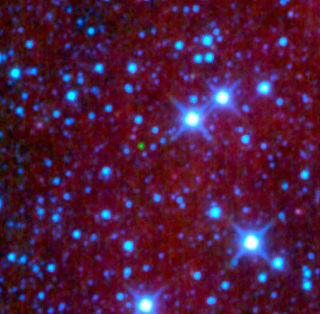| Observation data Epoch J2000 Equinox J2000 | |
|---|---|
| Constellation | Carina |
| Right ascension | 08h 17m 30.096s [1] |
| Declination | −61° 55′ 15.802″ [1] |
| Characteristics | |
| Spectral type | T6 [2] |
| Apparent magnitude (J) | 13.6 |
| J−H color index | 0.087 ± 0.039 [2] |
| J−K color index | 0.093 ± 0.049 [2] |
| Astrometry | |
| Radial velocity (Rv) | ? km/s |
| Proper motion (μ) | RA: 336 ± 54 mas/yr Dec.: 1095 ± 410 mas/yr |
| Parallax (π) | 204.08 ± 12.49 [2] mas |
| Distance | 16.0 ± 1.0 ly (4.9 ± 0.3 pc) |
| Details | |
| Mass | 0.015 [2] M☉ |
| Radius | ~0.1 R☉ |
| Temperature | 950 [2] K |
| Other designations | |
| Database references | |
| SIMBAD | data |
DENIS J081730.0-615520 (also known as 2MASS 08173001-6155158) is a T brown dwarf approximately 16 ly (4.9 pc) away in the constellation Carina. It was discovered by Etienne Artigau and his colleagues in April 2010. The star belongs to the T6 spectral class implying a photosphere temperature of about 950 K. It has a mass of about 15 MJ (Jupiter masses) or about 1.5% the mass of the Sun. [2]

A constellation is a group of stars that forms an imaginary outline or pattern on the celestial sphere, typically representing an animal, mythological person or creature, a god, or an inanimate object.

Carina is a constellation in the southern sky. Its name is Latin for the keel of a ship, and it was formerly part of the larger constellation of Argo Navis until that constellation was divided into three pieces, the other two being Puppis, and Vela.

Jupiter mass, also called Jovian mass, is the unit of mass equal to the total mass of the planet Jupiter. This value may refer to the mass of the planet alone, or the mass of the entire Jovian system to include the moons of Jupiter. Jupiter is by far the most massive planet in the Solar System. It is approximately 2.5 times more massive than all of the other planets in the Solar System combined.
DENIS J081730.0-615520 is the second-nearest isolated T dwarf to the Sun (after UGPS J0722-05) and the fifth-nearest (also after ε Indi Bab and SCR 1845-6357B) if one takes into account T dwarfs in multiple star systems. It is also the brightest T dwarf in the sky (in the J-band); it had been missed before due to its proximity to the galactic plane. [2]

Epsilon Indi is a star system approximately 12 light-years from Earth in the constellation of Indus consisting of a K-type main-sequence star, ε Indi A, and two brown dwarfs, ε Indi Ba and ε Indi Bb, in a wide orbit around it. The brown dwarfs were discovered in 2003. ε Indi Ba is an early T dwarf (T1) and ε Indi Bb a late T dwarf (T6) separated by 0.6 arcseconds, with a projected distance of 1460 AU from their primary star.

A star system or stellar system is a small number of stars that orbit each other, bound by gravitational attraction. A large number of stars bound by gravitation is generally called a star cluster or galaxy, although, broadly speaking, they are also star systems. Star systems are not to be confused with planetary systems, which include planets and similar bodies [such as comets.]

The galactic plane is the plane on which the majority of a disk-shaped galaxy's mass lies. The directions perpendicular to the galactic plane point to the galactic poles. In actual usage, the terms galactic plane and galactic poles usually refer specifically to the plane and poles of the Milky Way, in which Planet Earth is located.



